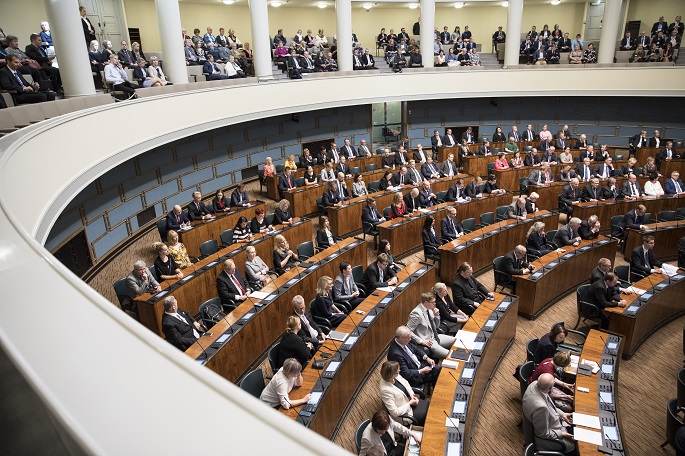Driving licence act reform proposal placed in Parliament
Published : 20 Oct 2017, 02:46
Updated : 20 Oct 2017, 11:48
The government on Thursday submitted a proposal for amending the Driving Licence Act to parliament, said a government press release.
The purpose of the proposal is to simplify and streamline the regulation of driving instruction and to promote the use of new alternative instruction and learning methods. The amendments proposed apply to licences other than those for driving lorries, buses, and coaches.
The acquisition of driving skills and a driving licence would still require instruction, but the contents of instruction would no longer be defined in such detail.
The provision of driving instruction and driving practice would still need a licence, and the instruction would incorporate sections emphasising safety.
“The amendments pay more attention to learners: what do they know, which training alternative suits them, and how much instruction do they need. There will be more alternatives for acquiring driving instruction,” said Minister of Transport and Communications Anne Berner.
“In order to maintain traffic safety, the difficulty of both theory tests and driving tests will be increased, and it is proposed that it would be compulsory for people acquiring a driving licence for a car to pass an eight-hour course on risk identification,” said Berner.
According to Berner, the objective of the legislative proposal is to dismantle Finnish regulations that are stricter than those applied by the EU, to promote digitalisation and online services and to ease the administrative burden of both the authorities and the companies providing instruction.
With the new act, obtaining a driving licence would put more emphasis on examinations at the same time as the difficulty of the examinations would be increased. It would no longer be necessary for the authorities to confirm the instruction plans, and the process of obtaining a Category B driving licence would no longer be divided into the current phases.
Besides increasing the difficulty of examinations, new drivers would be monitored for offences more efficiently than now. Returning the driving licence after a driving ban would require additional training to prevent risk behaviour, if the traffic offences leading to the driving ban are committed during the first two years.
People acquiring their driving licences would be required to take training periods pertaining to traffic safety.
People acquiring their first driving licence would be required to pass a four-hour training course on the basics of traffic. This could also be given at school. Otherwise the training would be given at a driving school, or the instructor would be some other body approved by Trafi. A person acquiring a Category B licence would have to pass an eight-hour course on risk identification.
A minimum amount of driving instruction would also be compulsory for learners acquiring their first licence for a motorcycle and a Category B licence for a car. The minimum amount would be five hours for a motorcycle (now nine hours) and 10 hours for a Category B licence (now 18 hours).
The minimum age for starting driving instruction for a Category B licence would be lowered to 16 years, but the licence would not be granted until the age of 18 years. The exception is professional driver training, where the learner could get a driving licence at the age of 17 years. It is further proposed that the granting of exemptions to the minimum age for a driving licence would be slightly easier so that the necessary transport needs of young people and their families could be taken into account better.
When applying for driving licences other than those for lorries, buses and coaches, the applicant would affirm that the health requirements are met. When renewing a driving licence, a medical certificate would be required when the applicant is 70 years or older.
Several reforms are proposed to tractor categories and tractor licences. The Category LT would be given up. With the exception of certain tractors in vehicle category T3, a driving licence for Category T would entitle the holder to drive tractors with a maximum structural speed of 60 km/h.
Tractors in Category T3, such as four-wheelers with a maximum speed of 40-60 km/h, would be included in driving licence category AM, alongside light quadricycles (AM121). It would also be permissible to drive tractors with a Category B licence for cars.
After a consultation round, several changes were made to the draft act. It is proposed that the brake pedal requirement in teaching and examination vehicles remain unchanged, but an alteration inspection and a clutch pedal would no longer be required in a driving school vehicle.
The requirements for driving four-wheelers would be harmonised with the requirements for driving light quadricycles, and a driving test would also be needed for acquiring a licence for mopeds and light quadricycles. In Category B, the duration of the driving test would be extended.
The criminal register of an applicant for a driving instruction permit would still be checked, but the instructor's test would be given up. On the basis of experience, the driving licence category for a motorcycle could be upgraded in both ways enabled by the EU, i.e. a driving test without instruction or instruction (seven hours) without a driving test.
Nurses and public health nurses would receive the right to give notice about shortcomings in health requirements owing to continuous abuse of intoxicants.
Furthermore, the legislative proposal presents some changes to the approval of driving licences granted abroad. In the future, driving licences granted in counties outside the EU and EEA and the Geneva and Vienna Conventions on Road Traffic would be valid documents for driving in continental Finland. This would mean that, for example, Chinese travellers holding driving licences granted in China would be able to drive in Finland.
It is proposed that the act enter into force on 1 July 2018, with the exception of the approval of foreign driving licences, which would enter into force on 1 February 2018.


